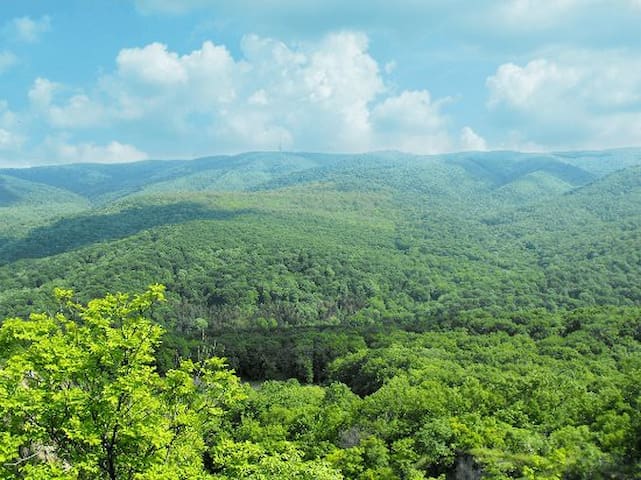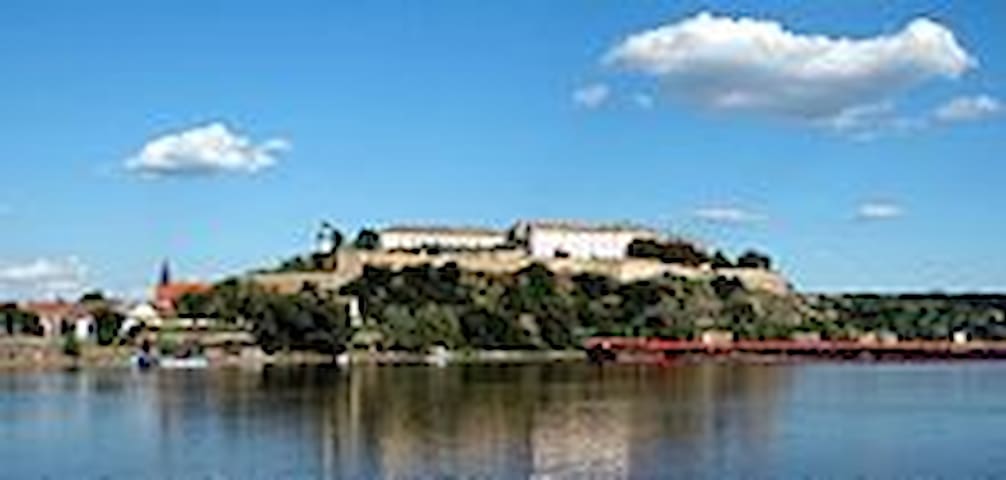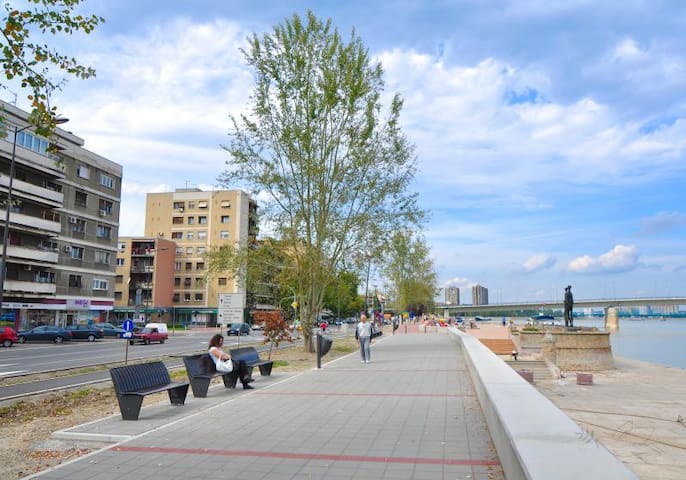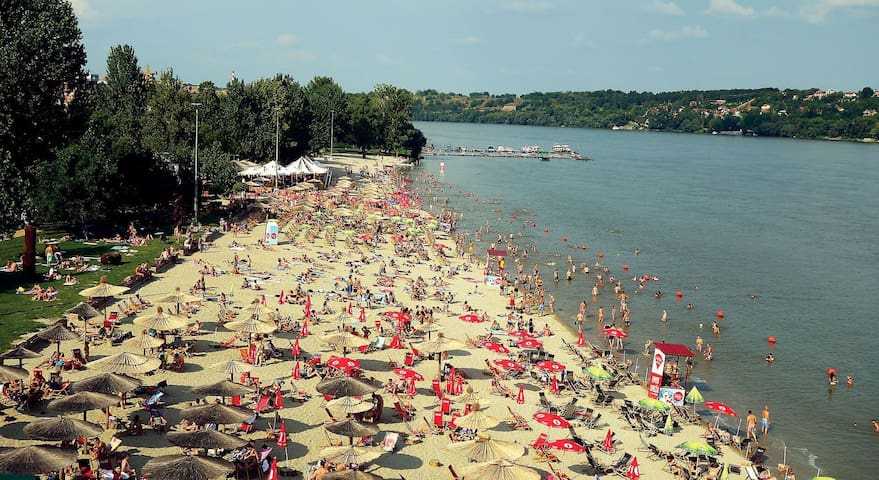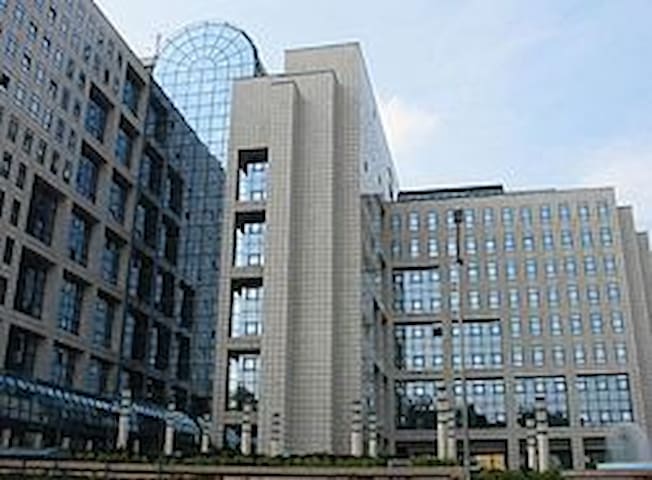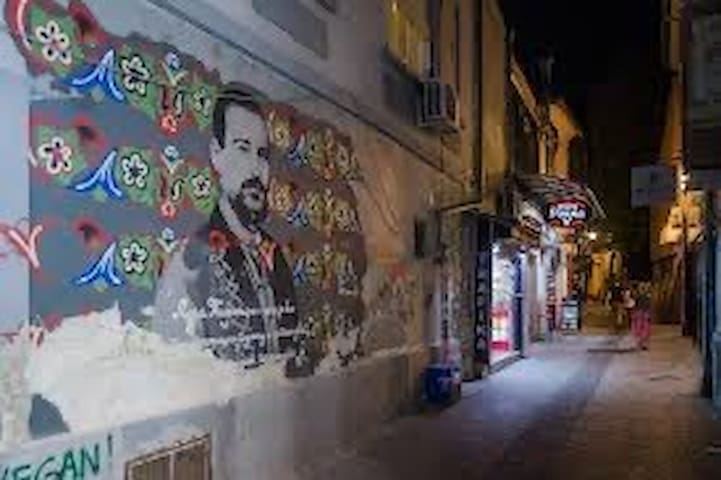Sightseeing
Must see in Novi Sad.
Novi Sad (Serbian Cyrillic: Нови Сад, pronounced [nôʋiː sâːd] (About this soundlisten); Hungarian: Újvidék [ˈuːjvideːk]; see below for other names) is the second largest city in Serbia and the capital of the autonomous province of Vojvodina. It is located in the southern portion of the Pannonian Plain on the border of the Bačka and Srem geographical regions. Lying on the banks of the Danube river, the city faces the northern slopes of Fruška Gora.
Novi Sad was founded in 1694 when Serb merchants formed a colony across the Danube from the Petrovaradin Fortress, a strategic Habsburg military post. In the following centuries, it transformed into an important trading and manufacturing centre as well as a centre of Serbian culture, earning it the nickname Serbian Athens. The city was heavily devastated in the 1848 Revolution, but was subsequently rebuilt and restored. Today, along with the Serbian capital city of Belgrade, Novi Sad is an industrial and financial centre important to the Serbian economy.
Novi Sad is the European Capital of Culture for the year 2021 and European Youth Capital 2019.
34 personas del lugar lo recomiendan
City Centre
Novi Sad (Serbian Cyrillic: Нови Сад, pronounced [nôʋiː sâːd] (About this soundlisten); Hungarian: Újvidék [ˈuːjvideːk]; see below for other names) is the second largest city in Serbia and the capital of the autonomous province of Vojvodina. It is located in the southern portion of the Pannonian Plain on the border of the Bačka and Srem geographical regions. Lying on the banks of the Danube river, the city faces the northern slopes of Fruška Gora.
Novi Sad was founded in 1694 when Serb merchants formed a colony across the Danube from the Petrovaradin Fortress, a strategic Habsburg military post. In the following centuries, it transformed into an important trading and manufacturing centre as well as a centre of Serbian culture, earning it the nickname Serbian Athens. The city was heavily devastated in the 1848 Revolution, but was subsequently rebuilt and restored. Today, along with the Serbian capital city of Belgrade, Novi Sad is an industrial and financial centre important to the Serbian economy.
Novi Sad is the European Capital of Culture for the year 2021 and European Youth Capital 2019.
Fruška Gora (Serbian Cyrillic: Фрушка гора) is a mountain in northern Serbia. Most of the area is administratively part of Serbia, but a small part on its western side extends into eastern Croatia. The area under Serbia forms one of the country's national parks. Sometimes it is also referred to as jewel of Serbia due to its largely pristine landscape and protection effort.
A national park Fruška Gora was declared in 1960 and covers an area of 266.72 km2 (102.98 sq mi). It is the oldest modern national park in Serbia.
Ottoman documents mention 35 monasteries, of which 16 survived and are still active today. Due to the such large number of monasteries on one place, Fruška Gora is colloquially called Serbian Mount Athos.[2] The Holy Synod of the Serbian Orthodox Church officially declared Fruška Gora the Holy Mountain on 12 October 2003.
92 personas del lugar lo recomiendan
Fruska Gora
Fruška Gora (Serbian Cyrillic: Фрушка гора) is a mountain in northern Serbia. Most of the area is administratively part of Serbia, but a small part on its western side extends into eastern Croatia. The area under Serbia forms one of the country's national parks. Sometimes it is also referred to as jewel of Serbia due to its largely pristine landscape and protection effort.
A national park Fruška Gora was declared in 1960 and covers an area of 266.72 km2 (102.98 sq mi). It is the oldest modern national park in Serbia.
Ottoman documents mention 35 monasteries, of which 16 survived and are still active today. Due to the such large number of monasteries on one place, Fruška Gora is colloquially called Serbian Mount Athos.[2] The Holy Synod of the Serbian Orthodox Church officially declared Fruška Gora the Holy Mountain on 12 October 2003.
Petrovaradin Fortress (Serbian: Петроварадинска тврђава/Petrovaradinska tvrđava, pronounced [pɛtrɔv̞arǎdiːnskaː tv̞ř̩dʑav̞a], Hungarian: Péterváradi vár), nicknamed "Gibraltar on/of the Danube" is a fortress in the town of Petrovaradin, itself part of the City of Novi Sad, Serbia. It is located on the right bank of the Danube river. The cornerstone of the present-day southern part of the fortress was laid on 18 October 1692 by Charles Eugène de Croÿ. Petrovaradin Fortress has many tunnels as well as 16 km of uncollapsed underground countermine system.
In 1991 Petrovaradin Fortress was added to Spatial Cultural-Historical Units of Great Importance list, and it is protected by the Republic of Serbia.
23 personas del lugar lo recomiendan
Fortaleza de Petrovaradin
Petrovaradin Fortress (Serbian: Петроварадинска тврђава/Petrovaradinska tvrđava, pronounced [pɛtrɔv̞arǎdiːnskaː tv̞ř̩dʑav̞a], Hungarian: Péterváradi vár), nicknamed "Gibraltar on/of the Danube" is a fortress in the town of Petrovaradin, itself part of the City of Novi Sad, Serbia. It is located on the right bank of the Danube river. The cornerstone of the present-day southern part of the fortress was laid on 18 October 1692 by Charles Eugène de Croÿ. Petrovaradin Fortress has many tunnels as well as 16 km of uncollapsed underground countermine system.
In 1991 Petrovaradin Fortress was added to Spatial Cultural-Historical Units of Great Importance list, and it is protected by the Republic of Serbia.
There are walking routes for tourist on Suncani kej. It is next to Dunav, and you can see Petrovaradin Fortress.
The monument to the victims of the raid in Novi Sad was erected in 1971 and represents a famous place as an immovable cultural asset of great importance.
In Novi Sad, on the quay that today bears the Quay of the victims of the raid, the fascist occupier carried out a mass shooting of more than a thousand innocent citizens of Novi Sad in the so-called "January raid" from January 21 to 23, 1942. A bronze composition "Family", 4 m high, dedicated to the victims of the Second World War, was erected at that place.
16 personas del lugar lo recomiendan
Sunčani Kej
Sunčani kejThere are walking routes for tourist on Suncani kej. It is next to Dunav, and you can see Petrovaradin Fortress.
The monument to the victims of the raid in Novi Sad was erected in 1971 and represents a famous place as an immovable cultural asset of great importance.
In Novi Sad, on the quay that today bears the Quay of the victims of the raid, the fascist occupier carried out a mass shooting of more than a thousand innocent citizens of Novi Sad in the so-called "January raid" from January 21 to 23, 1942. A bronze composition "Family", 4 m high, dedicated to the victims of the Second World War, was erected at that place.
Swimming
Must visit Public beach. Only 5 minutes from Appartment.
Štrand (Serbian Cyrillic: Штранд) is a popular beach on the Danube river in Novi Sad, Vojvodina, Serbia. It is located near the Liberty Bridge, in the city quarter known as Liman.
Štrand was built back in 1911, as a beach for local people; later it was expanded several times.[1] Its name derives from the German word Strand, meaning simply beach (In German, an initial s is usually pronounced as sh when it comes before a consonant, as in the Yiddish-English shtick, thus, the Serbian š correctly bears a diacritic reflecting this).
107 personas del lugar lo recomiendan
Štrand
Štrand (Serbian Cyrillic: Штранд) is a popular beach on the Danube river in Novi Sad, Vojvodina, Serbia. It is located near the Liberty Bridge, in the city quarter known as Liman.
Štrand was built back in 1911, as a beach for local people; later it was expanded several times.[1] Its name derives from the German word Strand, meaning simply beach (In German, an initial s is usually pronounced as sh when it comes before a consonant, as in the Yiddish-English shtick, thus, the Serbian š correctly bears a diacritic reflecting this).
Neighborhoods
Near Appartment
Liman (Serbian Cyrillic: Лиман) is an urban neighborhood of the city of Novi Sad, Serbia. It is located to the south of the city centre, along the Danube river, covering an area of 3.98 km². It is a relatively new part of the city, built between 1960s and 1990s on what previously were marshes. It is divided into four parts, numbered by Roman numerals: Liman I (with University campus), II, III and IV, which match the chronology of its development.
The northern border of Liman is Bulevar Cara Lazara (Tsar Lazar Boulevard), the western borders are Ulica Ribarsko ostrvo (Ribarsko ostrvo Street) and Ulica Sima Matavulja (Simo Matavulj Street), while the southern and eastern border is Danube river (i.e. Sunčani kej - "The Sunny Quay").
The neighbouring neighbourhoods are: Telep in the west, Adamovićevo Naselje, Grbavica and Stari Grad in the north, and Ribarsko ostrvo (not a settlement, but tourist destination) in the south. In the south-east of the settlement is river Danube.
There are many walking routes in Limanski park, located at Liman 3.
Liman 3
Liman (Serbian Cyrillic: Лиман) is an urban neighborhood of the city of Novi Sad, Serbia. It is located to the south of the city centre, along the Danube river, covering an area of 3.98 km². It is a relatively new part of the city, built between 1960s and 1990s on what previously were marshes. It is divided into four parts, numbered by Roman numerals: Liman I (with University campus), II, III and IV, which match the chronology of its development.
The northern border of Liman is Bulevar Cara Lazara (Tsar Lazar Boulevard), the western borders are Ulica Ribarsko ostrvo (Ribarsko ostrvo Street) and Ulica Sima Matavulja (Simo Matavulj Street), while the southern and eastern border is Danube river (i.e. Sunčani kej - "The Sunny Quay").
The neighbouring neighbourhoods are: Telep in the west, Adamovićevo Naselje, Grbavica and Stari Grad in the north, and Ribarsko ostrvo (not a settlement, but tourist destination) in the south. In the south-east of the settlement is river Danube.
There are many walking routes in Limanski park, located at Liman 3.
Shoping and Market
Shooping for clothes and buying used and second hand items, with alot of places to eat food.
Nylon Market is the largest market in Novi Sad. It covers 38,000 m2 with a total of 2,856 outlets, which includes a car market with 509 outlets. The market is open on Fridays, Saturdays and Sundays. It is estimated that more than 50,000 people visit the market on Sunday, which is a hit day.
It was created spontaneously in the 1960s on the right side of Temerin Road. [2] Initially, it consisted of two rows of nylon and newspapers placed on the ground, to which citizens took out and sold worn-out clothes and shoes, old defective appliances and other second-hand goods. That is where the market got its name. By moving to the left side of Temerin Road, the Nylon Market has over time grown into a real flea market with a wide range of various second-hand goods, antiques, used cars, furniture, timber, firewood, livestock and animal feed, pets, etc.
Based on the regulation plan, the Nylon Market was significantly expanded in 2003 and 2004, and extensive works were carried out on arranging the plateau, infrastructure, construction of entrance-exit ramps, two sanitary facilities were built for tenants and visitors, etc.
The market is traditionally open on Sundays, since 2007 the market day has been extended to Saturday, and since 2011 to Friday. On Fridays and Saturdays, mostly second-hand goods are sold, and on Sundays, new goods.
The market is located north of the Danube-Tisa-Danube Canal, in the Vidovanski settlement, next to the Temerin road that connects the city center with the Belgrade-Subotica highway. It is about 3.5 kilometers away from the center, and about 2.5 kilometers from the highway.
The market can be reached from the direction of the city center, Futoška market and the railway station by line no. 5, and on Sundays and the 5N line. Slightly further away is line no. 1 which travels through the center to Liman 1.
Playa de Najlon
1 Temerinski putNylon Market is the largest market in Novi Sad. It covers 38,000 m2 with a total of 2,856 outlets, which includes a car market with 509 outlets. The market is open on Fridays, Saturdays and Sundays. It is estimated that more than 50,000 people visit the market on Sunday, which is a hit day.
It was created spontaneously in the 1960s on the right side of Temerin Road. [2] Initially, it consisted of two rows of nylon and newspapers placed on the ground, to which citizens took out and sold worn-out clothes and shoes, old defective appliances and other second-hand goods. That is where the market got its name. By moving to the left side of Temerin Road, the Nylon Market has over time grown into a real flea market with a wide range of various second-hand goods, antiques, used cars, furniture, timber, firewood, livestock and animal feed, pets, etc.
Based on the regulation plan, the Nylon Market was significantly expanded in 2003 and 2004, and extensive works were carried out on arranging the plateau, infrastructure, construction of entrance-exit ramps, two sanitary facilities were built for tenants and visitors, etc.
The market is traditionally open on Sundays, since 2007 the market day has been extended to Saturday, and since 2011 to Friday. On Fridays and Saturdays, mostly second-hand goods are sold, and on Sundays, new goods.
The market is located north of the Danube-Tisa-Danube Canal, in the Vidovanski settlement, next to the Temerin road that connects the city center with the Belgrade-Subotica highway. It is about 3.5 kilometers away from the center, and about 2.5 kilometers from the highway.
The market can be reached from the direction of the city center, Futoška market and the railway station by line no. 5, and on Sundays and the 5N line. Slightly further away is line no. 1 which travels through the center to Liman 1.
Promenada is a big shopimg mall built in 2018. There are many shops where you can buy clothes, and also on the top floor there are many restaurants, mainly fast food, and Cinema.
It is opened 10-22 h.
https://promenadanovisad.rs/en/
40 personas del lugar lo recomiendan
Promenada
119 Bulevar oslobođenjaPromenada is a big shopimg mall built in 2018. There are many shops where you can buy clothes, and also on the top floor there are many restaurants, mainly fast food, and Cinema.
It is opened 10-22 h.
https://promenadanovisad.rs/en/
Food scene and Nightlife (Clubs)
Restaurants and Clubs to visit
Ribarsko Ostrvo (Fisherman’s Island) occupies a peaceful setting on the Danube riverbank, 4 km from Novi Sad town centre. It features a stylish restaurants and free Wi-Fi throughout the Island.
Swimming is possible at the nearby Strand Beach. Sailing along the Danube with a small boat can be arranged.
Before entering the weekend settlement Ribarac, you will find the tourist settlement Fisherman's Island consisting of several boats, huts and restaurants, popular among Novi Sad residents and very attractive locations for weddings, especially after the complete reconstruction of bungalows and restaurants in late 2010. Because of this, on weekends, it is necessary to find out if a restaurant has already been reserved for a private celebration.
The tourist resort consists of the Danube huts, the restaurant Alaska Barka, Alaska Terrace and the restaurant Ribarac.
On the left side of the settlement, there are private rafts, across which you can see a part of the Quay and the peak of the Strand beach (the peak is also the name for the end point of Ribarc, from which you can see the end of the Strand). Along the Danube, towards the Fortress, there was a set of buildings called Brukšanc, a small fortification that provided a pontoon bridge. A few hundred meters upstream, there was a swimming pool with a wooden building on the water, which was replaced by the Strand, which was discovered by officers as a place for swimming, swimming and rowing during the war years. Because of this, even today the wild beach on the Danube is called Oficirac.
Nearby are the Picnic Restaurant, Skipper Yachting Club, as well as the Two Seagulls and Cristal rafts, ideal for folk music lovers.
The most famous restaurant on the island is "Kućerak kod česme", which is located next to the fountain that serves as a landmark on the island. Dunavac, view of Strand, tamburitza players and fish specialties are the main features of this restaurant. Traditionally, a competition in making fish soup (organized by the Ribarac club) is held here every year during August. The participants are mostly "locals" of the island, ie owners of cottages in this settlement.
Not far from Ribarac is Bećarac.
35 personas del lugar lo recomiendan
Ribarsko ostrvo
Ribarsko Ostrvo (Fisherman’s Island) occupies a peaceful setting on the Danube riverbank, 4 km from Novi Sad town centre. It features a stylish restaurants and free Wi-Fi throughout the Island.
Swimming is possible at the nearby Strand Beach. Sailing along the Danube with a small boat can be arranged.
Before entering the weekend settlement Ribarac, you will find the tourist settlement Fisherman's Island consisting of several boats, huts and restaurants, popular among Novi Sad residents and very attractive locations for weddings, especially after the complete reconstruction of bungalows and restaurants in late 2010. Because of this, on weekends, it is necessary to find out if a restaurant has already been reserved for a private celebration.
The tourist resort consists of the Danube huts, the restaurant Alaska Barka, Alaska Terrace and the restaurant Ribarac.
On the left side of the settlement, there are private rafts, across which you can see a part of the Quay and the peak of the Strand beach (the peak is also the name for the end point of Ribarc, from which you can see the end of the Strand). Along the Danube, towards the Fortress, there was a set of buildings called Brukšanc, a small fortification that provided a pontoon bridge. A few hundred meters upstream, there was a swimming pool with a wooden building on the water, which was replaced by the Strand, which was discovered by officers as a place for swimming, swimming and rowing during the war years. Because of this, even today the wild beach on the Danube is called Oficirac.
Nearby are the Picnic Restaurant, Skipper Yachting Club, as well as the Two Seagulls and Cristal rafts, ideal for folk music lovers.
The most famous restaurant on the island is "Kućerak kod česme", which is located next to the fountain that serves as a landmark on the island. Dunavac, view of Strand, tamburitza players and fish specialties are the main features of this restaurant. Traditionally, a competition in making fish soup (organized by the Ribarac club) is held here every year during August. The participants are mostly "locals" of the island, ie owners of cottages in this settlement.
Not far from Ribarac is Bećarac.
Alot of Clubs to see at night, also during the day there are plenty Restaurants to serve food. It is opened during the weekend until around 3 am, and during the work days until 1 am.
10 personas del lugar lo recomiendan
Laze Telečkog
Laze TelečkogAlot of Clubs to see at night, also during the day there are plenty Restaurants to serve food. It is opened during the weekend until around 3 am, and during the work days until 1 am.
Exit (Serbian: Егзит / Egzit; stylized as EXIT) is a summer music festival which is held at the Petrovaradin Fortress in Novi Sad, Serbia.
Founded in 2000, it has twice won the Best Major Festival award at the European Festivals Awards, for 2013 and 2017. EXIT has also won the “Best European Festival” award at the UK Festival Awards in 2007.
In March 2018 Regional Cooperation Council awarded EXIT Festival as Champion of Regional Cooperation for 2017.
The festival was founded in 2000 in Novi Sad, Serbia as a student movement, fighting for democracy and freedom in Serbia and the Balkans. After the Yugoslavian general election in 2000, Exit moved from the city's university park to the Petrovaradin Fortress in the same city in 2001. Nonetheless, social responsibility is still key aspect of the festival activities.
21 personas del lugar lo recomiendan
Festival Exit
Exit (Serbian: Егзит / Egzit; stylized as EXIT) is a summer music festival which is held at the Petrovaradin Fortress in Novi Sad, Serbia.
Founded in 2000, it has twice won the Best Major Festival award at the European Festivals Awards, for 2013 and 2017. EXIT has also won the “Best European Festival” award at the UK Festival Awards in 2007.
In March 2018 Regional Cooperation Council awarded EXIT Festival as Champion of Regional Cooperation for 2017.
The festival was founded in 2000 in Novi Sad, Serbia as a student movement, fighting for democracy and freedom in Serbia and the Balkans. After the Yugoslavian general election in 2000, Exit moved from the city's university park to the Petrovaradin Fortress in the same city in 2001. Nonetheless, social responsibility is still key aspect of the festival activities.
Consejos sobre la ciudad
Cómo moverse
There are no Subways. The only public transportation is Bus.
You can easily buy ticket on the first door from the driver. It is around 0,5 euros (prepare dinars) in one way. Bus line number 4, 11, 9 and 12 are going to City Center. Number 9 is going to Petrovaradin (for Exit Festival and sightseeing of Fortress). Numbers 4, 7 and 11 are going directly to Main Train Station.
You can also call the Taxi (Red taxi, Crveni taksi, Delta, MB, VIP...).
Train station is used if you want to go to another city.
There are no Subways.


